American Pit Bull Terrier vs. Staffordshire Bull Terrier: How Are They Different?

Photo by Photo by Chewy
Telling an American Pit Bull Terrier apart from a Staffordshire Bull Terrier can be a little tricky.
For one, they look similar, with muscular builds, short coats, and adorable blocky heads. If that wasn’t enough, the terms “Pit Bull” and “Staffy” are often used as catch-alls for multiple bully breeds, including American Staffordshire Terriers.
To further complicate matters, the American Pit Bull Terrier isn’t recognized by the American Kennel Club (AKC) as an official breed, although it is recognized by the United Kennel Club (UKC). Meanwhile, the Staffordshire Bull Terrier has full AKC recognition.
So, how do you tell these lovable look-alikes apart? In this guide, we’ll break down the differences between American Pit Bull Terriers versus Staffordshire Bull Terriers, from appearance to personality. By the end, you’ll have a clearer picture of which breed is the better match for your family.
Key Takeaways
- American Pit Bull Terriers and Staffordshire Bull Terriers share a common history and similar looks, but they are two different breeds.
- Both breeds are affectionate, people-oriented, and thrive with consistent socialization, training, exercise, and mental stimulation.
- Pit Bulls are larger and slightly more athletic than Staffies, who are smaller and famously gentle around children.
- Both breeds have low-maintenance grooming needs.
History
Both the Pit Bull and the Staffy have origins in 19th-century England, where breeders crossed Bulldogs with various terrier breeds. The goal was to create a breed with the Bulldog’s strength and the terriers’ determination and energy.
Unfortunately, these traits were exploited for bull-baiting and dog fighting. However, it’s important to note that this painful history reflects the role these dogs were forced into—not an innate tendency toward aggression or fighting. These breeds have always been eager to please and were simply trained to follow their humans’ leads.
And while some people used these dogs’ strength and drive for the wrong purposes, others recognized their true potential. From the very beginning, both Pit Bulls and Staffies were valued as versatile working dogs and beloved family companions.
Staffordshire Bull Terriers, for example, often helped with tasks like pest control and were prized for their people-loving nature. Lorelei Craig, who handles public education for the Staffordshire Bull Terrier Club of America (SBTCA), notes that Staffies are known for being especially good with children.
American Pit Bull Terriers were equally adaptable and eager to take on whatever jobs their families needed. As Christopher “Bully the Kid” Bennett, chief spokesman for the American Bully Kennel Club (ABKC), explains, “The breed served as a vermin remover, cattle dog … and often simply as a pet.”
Appearance
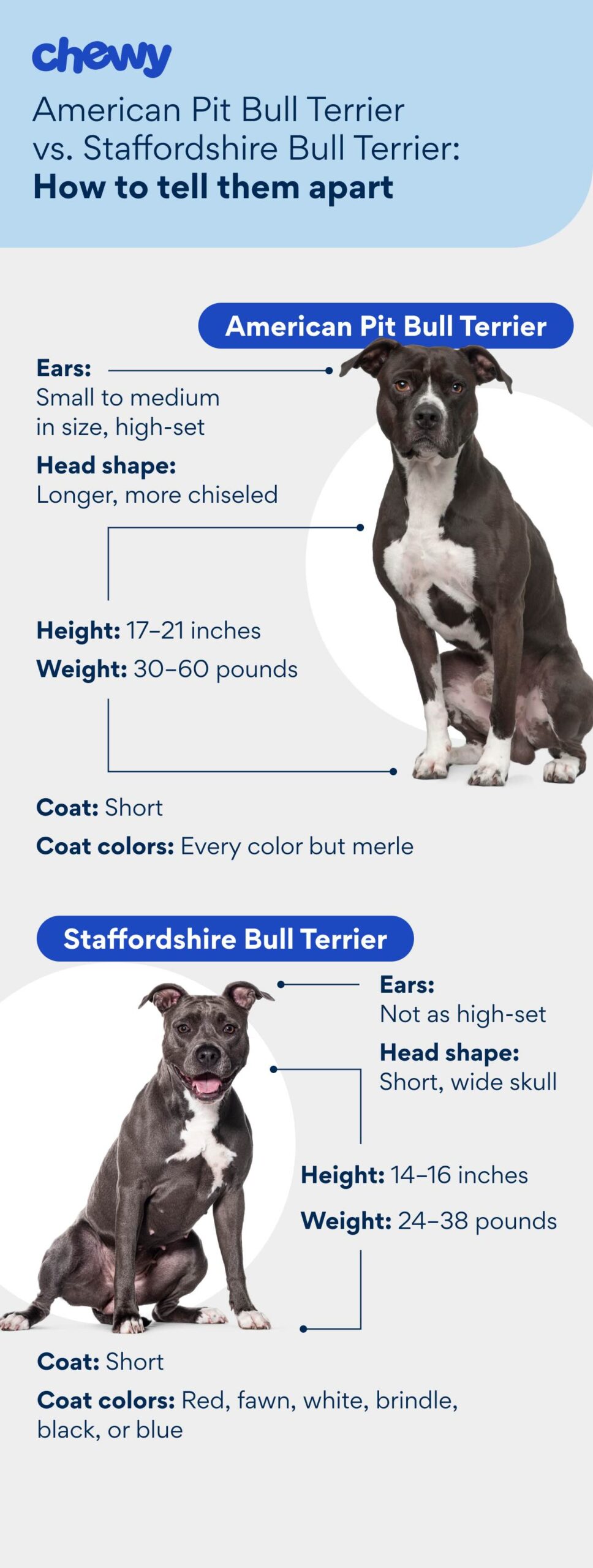
Photo by Chewy
American Pit Bull Terriers and Staffordshire Bull Terriers look similar at first glance, but they’re not identical. “The Staffordshire Bull Terrier is smaller than people realize,” says Craig. And size is just the start—here’s what else sets them apart:
- Height: When comparing a Staffy and a Pit Bull, look at their height. Pit Bulls are typically taller, at 17–21 inches, while Staffies are a little shorter, at 14–16 inches.
- Weight: Pit Bulls generally weigh 30–60 pounds, compared to the Staffy’s average of 24–38 pounds.
- Head shape: Both have the classic blocky head, but Pit Bulls usually have a longer, more chiseled look, while Staffords feature a shorter, wider skull.
- Ears: Staffies have signature “rose ears” with two distinctive folds, while Pit Bull ears are set higher on their head.
- Coat: Both breeds have a short, smooth coat that’s easy to maintain. Both coats can come in several colors, including black, white, red, fawn, and brindle.
Personality
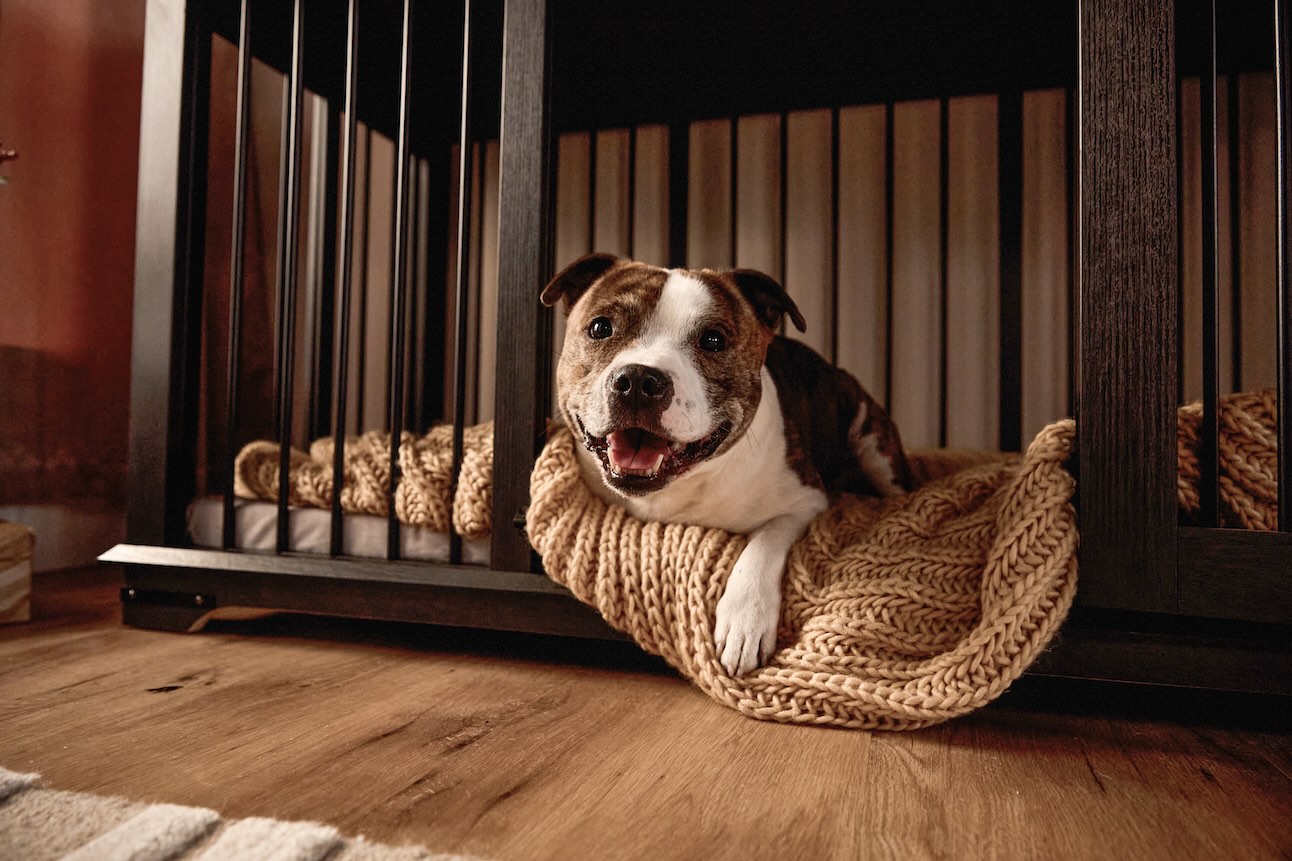
Photo by Chewy
These two breeds might look tough, but don’t let their muscles fool you—they’re both affectionate, friendly dogs. That said, each dog has their own personality quirks that make them special.
Staffordshire Bull Terriers are famously gentle with children, earning them the nickname “nanny dogs.” Craig says Staffords are “easygoing about new environments and situations,” especially with proper socialization, and they’re always up for a good time.
“They live life large,” says SBTCA President Tina Vickrey. “They have an infectious joy of life and adventure that’s impossible to ignore.”
This includes some unexpected behaviors, such as jumping.
“Staffords are catlike in their love of higher places, like the back of your couch, patio table, or even your counters,” says Vickrey. “They absolutely can jump that high from a standstill with zero effort.” So, pet parents might want to prioritize teaching their Staffy the “off” cue.
American Pit Bull Terriers are also outgoing, fun-loving dogs with equally big personalities. They bond deeply with their families and always want to be wherever you are, which is why they’re often called “Velcro dogs.” They’re also the comedians of the dog world.
“The best way to describe the breed’s temperament is determined and intense, yet clown-like,” says Bennett. “If you laugh at their behavior, they’re going to do that behavior over and over.”
Typical traits aside, remember that every dog is different.
“There can be a very wide variation in personality between individual dogs, no matter their breed,” says Lore Haug, DVM, MS, DACVB, CABC, a veterinary behaviorist at Texas Veterinary Behavior Services in Houston.
Exercise Needs
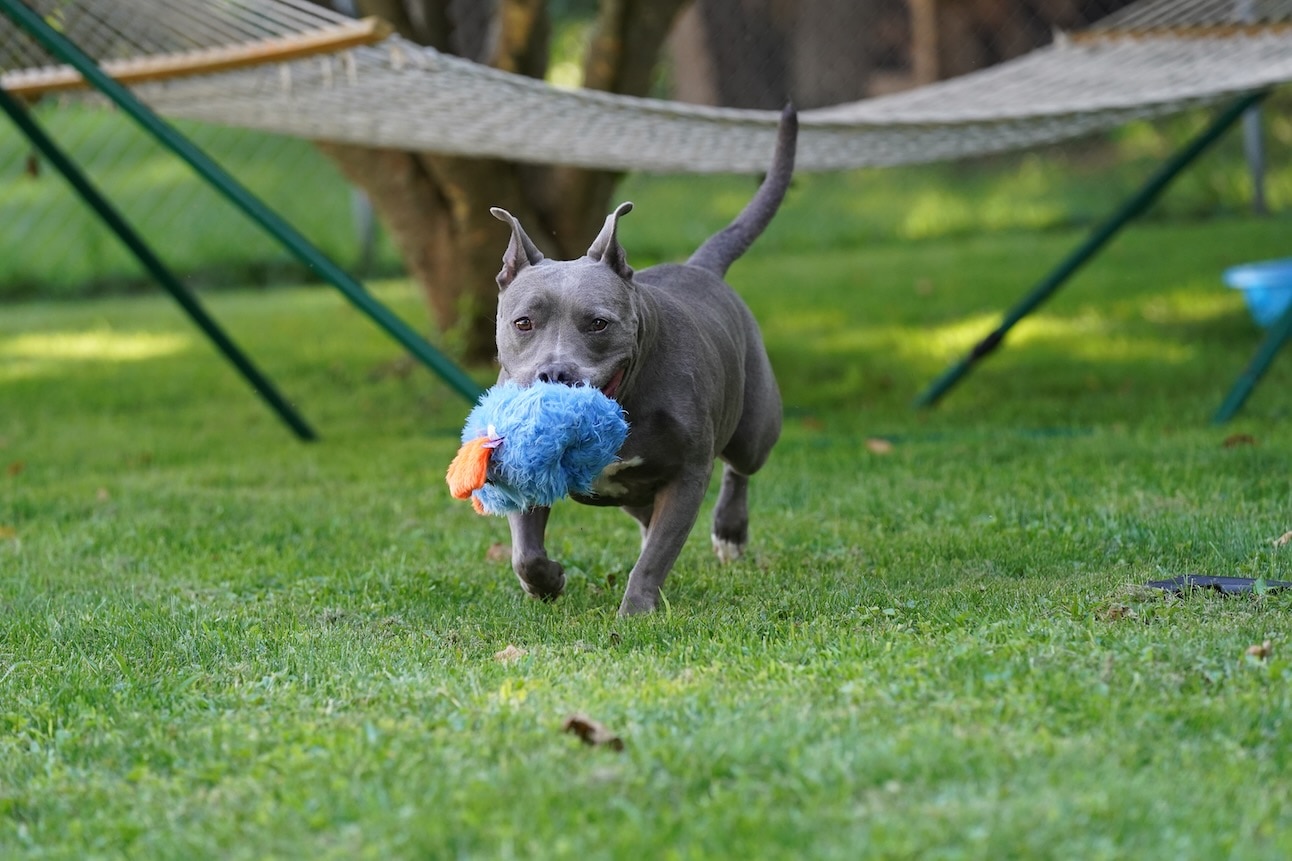
Photo by Chewy
You won’t find any couch potatoes here. These are both highly active dog breeds who need plenty of daily physical and mental stimulation to stay happy and healthy.
Bennett calls Pit Bulls the “ultimate canine athlete” and explains that even a casual three-mile walk might not be enough to tire them out. Instead, he recommends mixing in high-intensity activities that let them burn off energy, like:
- Twenty-minute games of fetch
Recommended Products
Recommended Product
Recommended Products
- Scent games or puzzle toys for mental stimulation
Recommended Product
Staffordshire Bull Terriers also need daily exercise, but they tend to enjoy activities that tap into their natural hunting instincts. Craig recommends the following activities:
- Nose work and scent-based games
- Lure coursing
- Dock diving and agility
- Obedience or trick training
But before you head out for a game of catch, know that many bully breeds like Staffies and Pit Bulls are prone to joint issues like hip dysplasia. Dr. Haug recommends tailoring workouts to your dog’s age, weight, and medical history to help prevent injury. When in doubt, check with your vet to keep exercise fun and safe.
Grooming
When it comes to Staffordshire Bull Terriers, “there is little to no grooming,” says Craig. She recommends wiping them down with a wet towel and giving them an occasional bath as needed. Because Staffies shed moderately year-round, a quick weekly brushing is all you need to manage loose fur and keep their coat looking healthy.
Recommended Product
American Pit Bull Terriers are just as low-fuss. Bennett recommends brushing them two to three times per week, plus monthly baths with a gentle shampoo and conditioner.
Recommended Product
Professional grooming isn’t necessary for either breed, but routine ear cleaning, teeth brushing, nail trims, and coat care should still be part of your schedule. A little maintenance goes a long way toward keeping these dogs looking (and smelling) their best.
Health
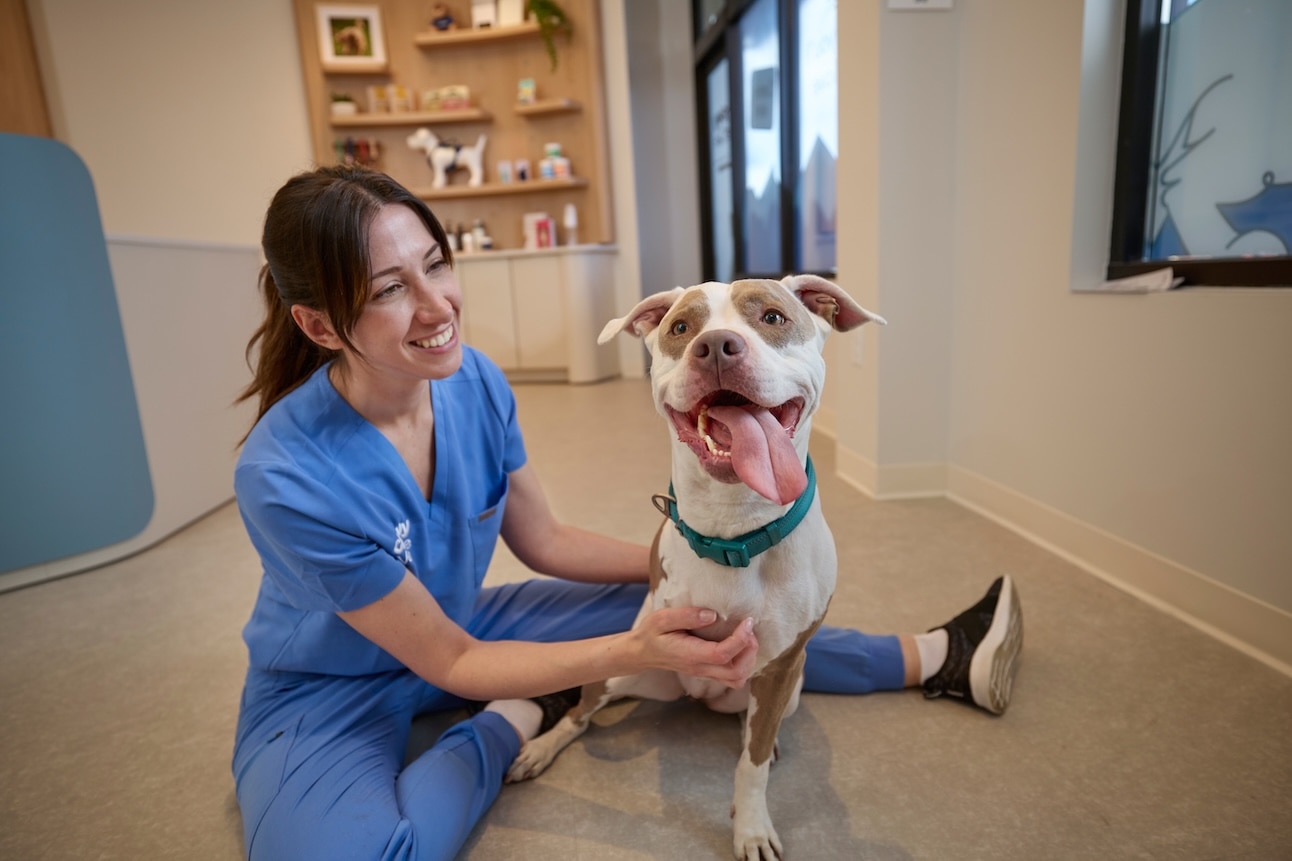
Photo by Chewy
Both breeds are generally healthy, but Dr. Haug says they share some common health concerns.
“The Pit Bull is generally a hardy breed,” says Bennett. “The typical health issues one should look for are hip and heart issues.” Because Pit Bulls often have a high pain tolerance, it can sometimes be harder to spot injuries or overexertion, especially in young dogs, so keeping an eye on their exercise levels is vital.
Staffordshire Bull Terriers also tend to be healthy, but Craig notes that they should be screened for genetic conditions, including cataracts and L-2-hydroxyglutaric aciduria (a rare metabolic disorder). Staffies are also sensitive to heat, so pet parents should be extra cautious when exercising them in warm weather.
For both breeds, vet checkups, a healthy weight, and preventive care are the best ways to catch potential issues early and keep your pup feeling their best.
American Pit Bull Terrier vs. Staffordshire Bull Terrier: Which Is Right for You?
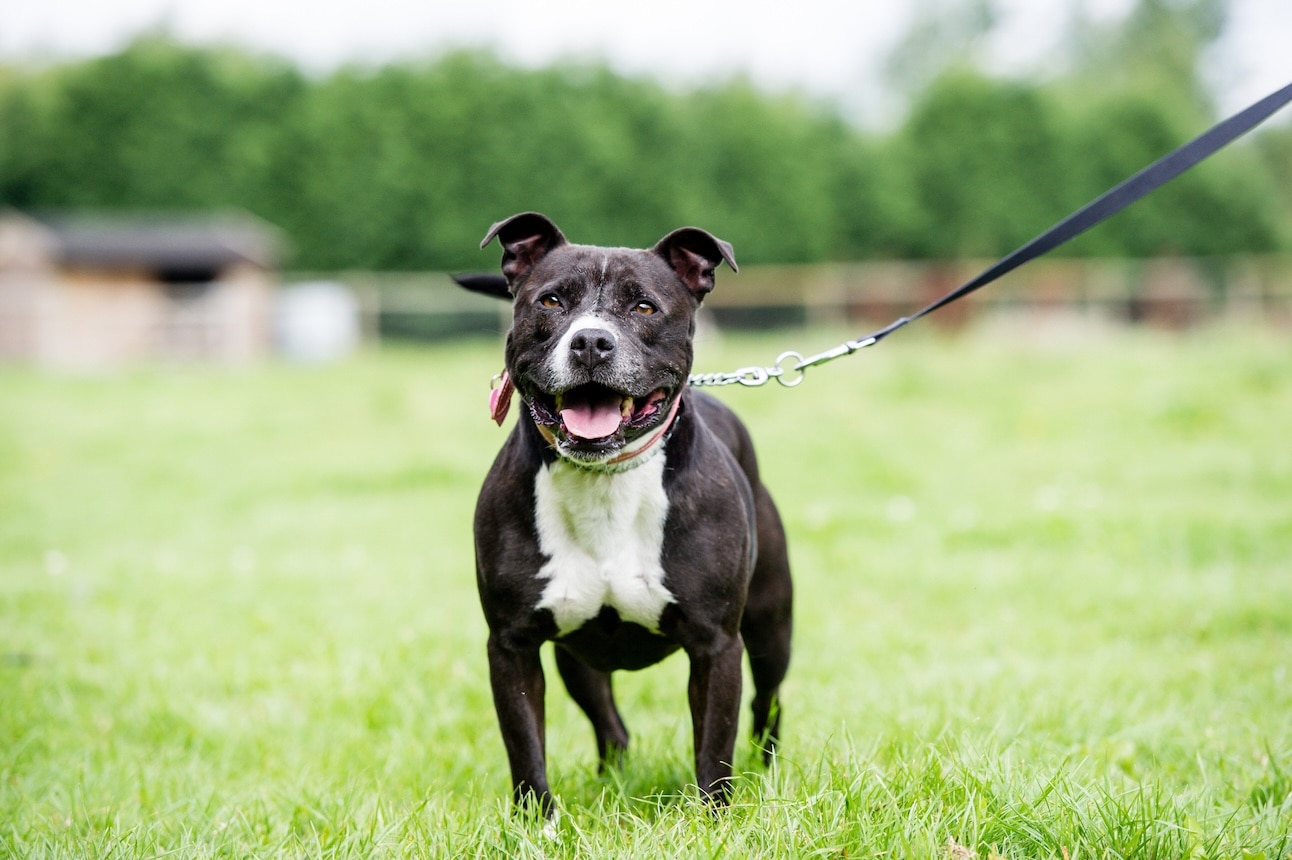
dageldog/iStock / Getty Images Plus via Getty Images
Ultimately, choosing between these breeds depends on your lifestyle and what you’re looking for in a new best friend.
The Staffordshire Bull Terrier’s “nanny dog” reputation and slightly calmer energy make them a great choice for families who want an affectionate, people-loving pup in a more manageable size.
American Pit Bull Terriers, on the other hand, are better suited for active pet parents who can provide plenty of high-intensity exercise and mental stimulation. These athletic dogs thrive when they have an outlet for their energy and a partner who can keep up.
Whichever breed you choose, lots of love, daily exercise, and mental stimulation are the keys to helping these pups live their happiest, healthiest lives.











